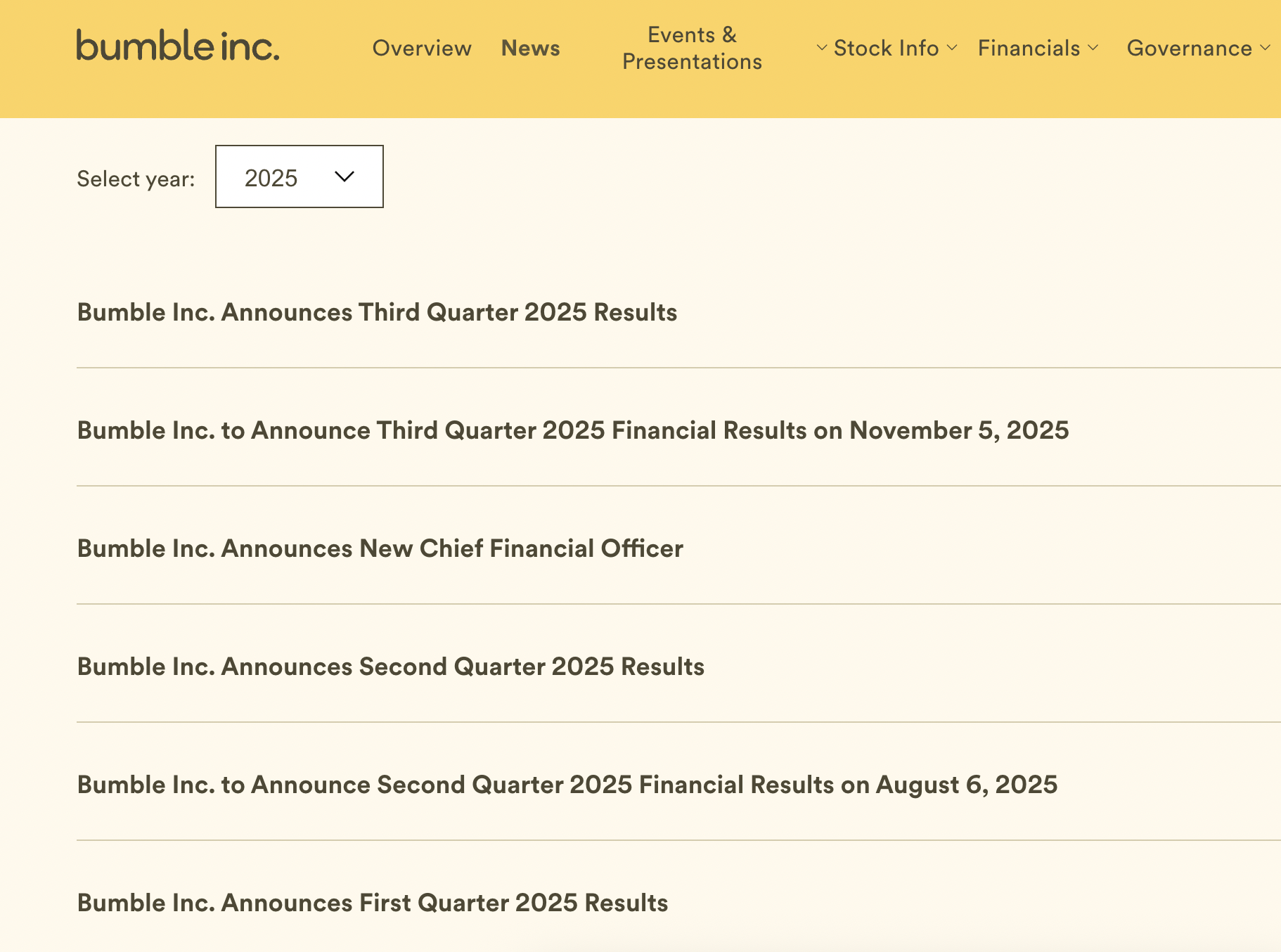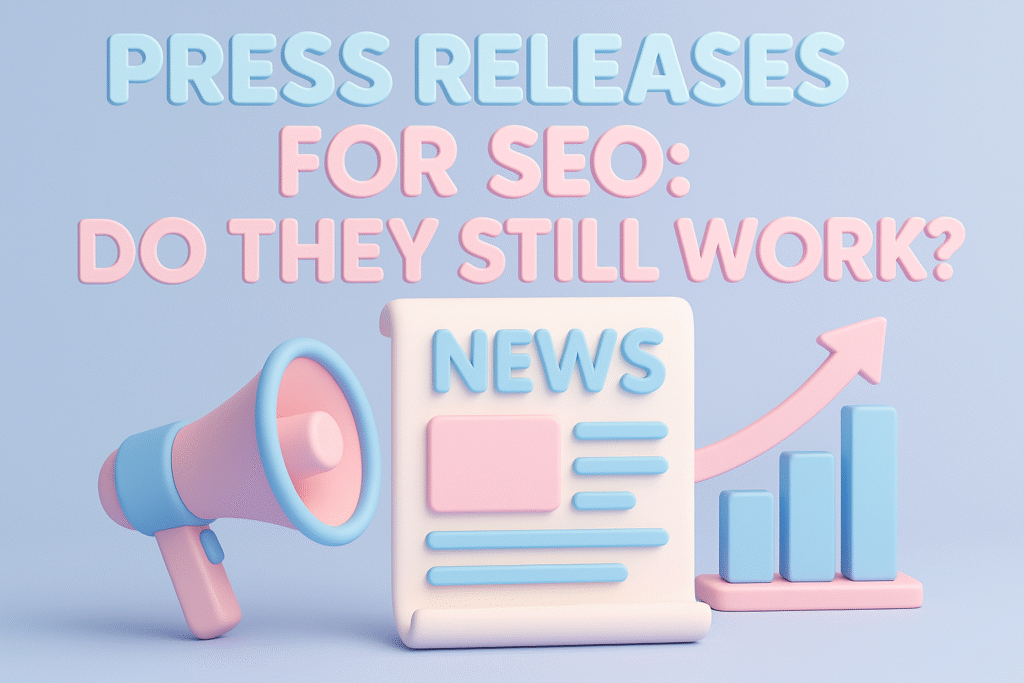You’ve probably heard it a hundred times: press releases don’t work anymore.
And honestly, for a while, that felt true. The old-school “blast it everywhere and hope for backlinks” strategy has been obsolete for years.
But here’s the thing: press releases never stopped working. Actually, they evolved.
In 2025, smart marketers are using SEO press releases as credibility engines: tools that earn mentions, visibility, and authority in a world run by algorithms and AI summaries.
And if you think that doesn’t affect SEO, think again. The #1 result on Google still gets a click-through rate (CTR) of about 27.6%, while the second drops to around 15%.
Visibility is everything. That’s exactly where a well-placed, well-optimized press release still makes an impact.
So yes, press releases can still help you rank. But only if you stop treating them like relics and start treating them like strategic SEO assets.
Let’s unpack how, shall we?
TL;DR
Here’s the short version before we dive deeper:
- Press releases still work for SEO, but only when they’re genuinely newsworthy and optimized for both Google and journalists.
- The days of spammy link-building are gone. Modern releases are about E-E-A-T: experience, expertise, authority, and trust.
- Done right, a single press release can skyrocket web traffic by up to 220%, boost visibility, and build long-term brand authority.
- Tools like Semrush, PR Newswire, and Business Wire help track the real metrics that matter: mentions, traffic, and citations.
- Forget cheap syndication. Focus on strategic distribution that reaches actual audiences, not empty websites.
- Consider working with a trusted press release service like EasyPR to ensure your news reaches high-authority outlets and delivers real SEO impact.
- In 2025, SEO press releases live at the crossroads of PR strategy, search intent, and digital storytelling.
What Is an SEO Press Release Today?
Press releases used to be a quick SEO shortcut; publish them everywhere, collect backlinks, and move on.
That approach doesn’t fly anymore.
In 2025, an SEO press release is a credibility strategy, not a backlink trick. Now, what matters is building authority.
Think of it this way: instead of shouting into the void, you’re shaping a story that both Google and real people actually find worth reading. One that gets referenced, quoted, and shared. That’s what drives rankings now.
What’s the Current Role of Press Releases in SEO?
So, what’s an SEO press release today?
It’s a newsworthy story built for both algorithms and humans. It blends smart optimization with storytelling that feels real.
Here’s what that looks like:
- Headlines that grab journalists and rank on search.
- Metadata that feeds search intent, not just keywords.
- Real quotes, real stats, real context; because AI can spot fluff a mile away.
The end goal of this? Trust signals. You’re showing Google your brand belongs in the conversation.
How It Differs from Old-School Press Releases
The old version of SEO PR was a total mess: full of stuffed keywords, duplicate content, and mass distribution. That was the kind of approach that gets flagged faster than you can say “Google update.”
Now it’s all about relevance and reputation.
Modern SEO press releases are focused on building your brand’s E-E-A-T (Experience, Expertise, Authority, and Trust). They’re clean, intentional, and tied to a real narrative.
Search engines can’t be tricked anymore, but they still reward brands that earn trust.
How SEO Press Releases Actually Help

Let’s be honest: an SEO press release won’t magically push you to position #1. But it can put you on Google’s radar in ways that regular blog posts can’t.
The key? Doing it strategically. Here’s how they actually move the needle:
Brand Mentions That Strengthen E-E-A-T
Google now pays close attention to who’s talking about you and how credible they are.
When respected publications, niche blogs, or media outlets mention your brand, those references act as trust signals. They tell search engines your business has real authority and presence in the market.
It’s important to track brand mentions across different platforms, as they can reveal valuable opportunities to strengthen your visibility and reputation.
Take this simple example: imagine a small fintech startup releasing a new savings feature. If Forbes or TechRadar mentions it in a “Top Finance Tools” roundup, that single mention does more for credibility than a hundred random backlinks ever could.
That’s why meaningful mentions carry more SEO weight than link volume. Each one builds authority that algorithms (and audiences) recognize.
Visibility That Drives Real Traffic
Press coverage still pulls weight when it’s done right.
Brands that execute strong, targeted releases see huge payoffs. Successful campaigns have lifted web traffic by up to 220%, proving that a strong news story can outperform another round of keyword-stuffed content.
This is the kind of visibility that matters: the kind that brings in actual people, not bots.
Link Equity (and Why It’s Overrated)
Let’s clear this up: backlinks still matter, but they’re no longer the prize everyone’s chasing.
As noted by Semrush, press releases boost SEO indirectly by driving discovery, building citations for local search, and protecting your online rep.
So stop obsessing over do-follows. Focus on distribution, citations, and reputation; that’s where the real SEO value lives now.
Modern Exposure That Fuels SEO
Press releases still matter because visibility still matters.
Today, they reach far beyond traditional news sites. Press releases now appear on AI-powered platforms such as ChatGPT, Gemini, Claude, and Google’s AI Overviews. That’s an exposure that regular content rarely achieves.
The results speak clearly: 68% of businesses reported stronger brand visibility in 2025 thanks to consistent PR efforts.
In short, PR has adapted to the new search reality. And it’s helping brands stay visible where attention is hardest to earn.
The Myths Killing Most SEO Press Releases
Most SEO press releases fail not because the channel’s dead, but because people are still using 2009 playbooks in a 2025 world.
If your release looks like a wall of corporate buzzwords with zero real news, no amount of “SEO optimization” is going to save it.
Let’s break down the biggest myths that are quietly killing your results:
“Press Releases Don’t Work Anymore”
This one refuses to die. The truth? They still work, just not for lazy marketers.
If you’re spamming generic announcements that no one would actually read, of course, they flop. But when your press release has a clear hook, data, and genuine relevance, it can open serious doors.
“It’s All About Do-Follow Links”
That mindset’s ancient history. Google’s been ignoring low-quality press release backlinks for years. What it cares about is the credibility of where your brand shows up.
So if you’re still chasing do-follows, you’re playing the wrong game.
Aim for mentions in credible outlets, not link farms. Those mentions build visibility, reputation, and real SEO equity.
“All Distribution Services Are the Same”
Here’s the hard truth: most aren’t even close.
There’s a massive difference between blasting your press release through a $49 syndication network and actually getting it read by journalists or editors who matter.
Those cheap networks? They’re 99% full of deindexed, low-quality sites. Google sees right through it.
If you want results, go targeted over massive. Pitch smart, not wide.
How to Create SEO Press Releases Step By Step
Let’s get practical. Modern SEO press releases are built for humans first, algorithms second. If your story doesn’t grab attention, no keyword can save it.
Here’s how to build one that earns attention, coverage, and rankings:

Step 1: Start with News That Deserves Attention
Let’s be honest; no amount of optimization will save a boring story.
If your announcement doesn’t matter to anyone outside your team, it won’t matter to Google either.
Strong SEO press releases start with actual news:
- A new product launch or feature update.
- A strategic partnership or funding round.
- Original data or insights worth reporting.
- Milestones that show momentum.
Ask yourself: would a journalist or your audience care about this? If the answer’s no, find a sharper angle before you write a single line.
Step 2: Write Like a Journalist, Optimize Like an SEO
Think of this step as merging two skill sets: editorial clarity and search precision.
A great SEO press release reads like something a journalist would write: clear, factual, and easy to quote. But it’s also optimized for the right keywords and metadata.
Here’s what to focus on:
- Headline: Keep it short, specific, and naturally include your keyword.
- First paragraph: Answer who, what, when, where, and why it matters.
- Quotes: Add authority and emotion; they break the monotony of facts.
- Keywords: Use them strategically in the headline, lead, and boilerplate, but don’t force them.
If an editor can scan it and instantly understand the story, you’re doing it right.
Step 3: Follow a Proven SEO Press Release Structure
There’s a reason top-performing press releases all look similar: structure builds clarity.
Journalists, editors, and search engines all scan for the same cues: headline, context, data, and source. If those pieces are missing or out of order, even the best story falls flat.
That’s why using a proven format matters. It helps your content read clean, rank fast, and look credible from first glance.
Here’s a framework you can follow :
- Logo: Reinforces your brand’s visual identity.
- Headline: Clear, keyword-rich, and instantly understandable.
- Subheadline: Adds a layer of context or a quick takeaway.
- Dateline (City, Date): Builds legitimacy and sets time relevance.
- Lead Paragraph: The essence of your news in one strong paragraph.
- Body: Expand with data, proof, and details that matter.
- Quotes: Add credibility with expert or executive statements.
- Boilerplate: A short “About Us” that ties back to your positioning.
- Contact Info: Who the media can reach if they want to know more.
Here’s an example of the framework put into practice:

Keep it concise; 400 to 600 words usually hits the sweet spot between SEO and readability.
Step 4: Pick the Right Distribution Channels
Even the best-written release won’t perform if it lands in the wrong places. Distribution is about precision; you want visibility in front of readers, not bots.
So, start with credible, high-authority platforms that Google trusts. Some solid options include Business Wire and GlobeNewswire.
Then, expand strategically: pitch journalists through Muck Rack or Qwoted, and repurpose your release on LinkedIn, industry newsletters, and relevant online communities.
When you distribute smart, every share becomes another signal of authority. That’s how a single announcement turns into a visibility chain reaction.
Step 5: Use Modern Visibility Boosters
Press releases today don’t just live on distribution platforms. Actually, they move across multiple touchpoints.
That means your work doesn’t end once you hit “publish.” The next step is amplification.
Here’s how to give your release that extra reach:
- Promote across channels: Share it on social, newsletters, and community boards.
- Use multimedia: Visuals, infographics, or a short video can keep readers engaged longer.
- Leverage influencers: A single share from an industry voice adds instant trust and reach.
- Experiment and measure: Test headlines, timing, or thumbnails to see what drives the most engagement.
The more signals you send (and the more people interact), the stronger your SEO footprint becomes.
Step 6: Measure What Actually Matters
You can’t improve what you don’t track. The best SEO press releases keep working long after publication because their results are measured, analyzed, and refined.
Forget vanity numbers like “total backlinks.” Focus instead on metrics that reflect real-world visibility and authority:
- Referral traffic and branded searches.
- Mentions from high-authority domains.
- Social engagement and dwell time.
- Coverage in AI summaries and news aggregators.
Tools like Google Search Console, Ahrefs, and Semrush Brand Monitoring help connect the dots between press coverage and search performance.
Step 7: Avoid the Usual Pitfalls
Even seasoned marketers trip over the same traps. Most SEO press releases fail because they try to game the system instead of working with it.
Here’s what to stay away from:
- Submitting to low-quality syndication networks that Google ignores.
- Overloading text with keywords or filler phrases.
- Announcements with no actual news angle.
- Publishing once and calling it a day.
At the end of the day, precision beats volume. A single, well-crafted release targeted to the right audience will outperform a dozen generic ones every time.
When Press Releases Make Sense in an SEO Strategy
Now, keep this in mind: you don’t need a press release for everything. If you’re pushing out random updates hoping to “get links,” you’ll waste time and budget.
Press releases shine when there’s real news behind them, something that deserves attention and can fuel search visibility naturally.
Here’s when they actually make sense:
Launches, Partnerships, and Announcements
New product? Strategic collaboration? Funding round? Those moments are perfect for a press release.
Why? Because they connect your SEO goals to real-world credibility. When journalists and industry blogs cover your story, that’s instant authority. And Google loves authority.
Plus, those announcements create fresh search intent. People start Googling your brand, product, or partnership, and that’s traffic money can’t buy.
Data-Driven Insights and Research Drops
This is where things get fun.
If you’ve gathered data (even small-scale insights), use it. Journalists crave stories backed by numbers. And data-backed press releases tend to earn organic backlinks naturally.
Think of it as giving the internet something worth citing. You become the source, not just another brand begging for coverage.
Managing Brand Reputation
Bad press, social backlash, or misinformation? A timely and transparent press release can turn the tide.
Handled right, it turns a crisis into an opportunity to show leadership and transparency. Beyond damage control, it’s about controlling the narrative.
And when Google indexes that official response, your voice becomes the version of the story that sticks.
Case Studies: Press Releases That Drove Real SEO Results
Still not convinced? Let’s look at real-world wins that prove modern press releases can still hit hard in 2025.
Case Study #1: How a Local Study Got Cogent Realty on Page One
A real estate firm in New York City, Cogent Realty Advisors, wanted to stand out in the packed office space market around Penn Station.
Instead of buying ads, they ran a local study comparing office costs in the area and shared the findings through a press release titled “Affordable Office Space Near Penn Station.”

That data-driven angle hit perfectly. The release was picked up by Yahoo News and several business outlets, generating backlinks from high-authority domains.
Within weeks, Cogent Realty ranked on Google’s first page for their main keywords, and the story continues to drive organic traffic today.
The takeaway? When your press release gives real insights, it earns both clicks and credibility.
Case Study #2: How Bumble Turns Press Releases into a Branding Engine
Unlike most brands that publish a release once in a while, Bumble treats PR as an ongoing part of its brand strategy.
The dating app regularly shares press releases about new features, community updates, and social awareness initiatives. All framed to reinforce its identity and values.

This steady rhythm keeps Bumble visible across multiple touchpoints and helps the brand own key search terms tied to relationships, dating, and safety.
Beyond Press Releases: Smarter Ways to Earn Links and Visibility
Press releases are just one move in a much bigger SEO playbook. If you stop there, you’re leaving serious visibility on the table.
Here’s how the smartest brands are stacking PR with other link-earning strategies that go further and last longer:
Digital PR Campaigns That Outperform Old Tactics
The best SEO stories start with creativity. Think surveys, viral stunts, or interactive data tools.
Those are the kinds of assets that get journalists and content creators coming to you for quotes or references.
Digital PR campaigns like these earn conversations. And conversations are what search algorithms are learning to prioritize.
Linkable Assets and Data Hubs That Journalists Love
Want to make your SEO future-proof? Build linkable resources instead of begging for coverage.
It could be a stats hub, a visual study, or an industry glossary; anything that gives genuine value to your niche.
Journalists love data they don’t have to dig for. Give it to them, and they’ll happily cite your site again and again.
This approach compounds over time. Every new mention reinforces your authority and feeds your search visibility on autopilot.
Partnered Content and Co-Branded Stories
Partnerships aren’t just for business deals. In content, they’re a goldmine.
Co-branded studies, webinars, or campaigns multiply reach by combining two audiences into one larger story.
And because they’re collaborative, they earn backlinks from both sides: a double hit for SEO authority.
In a world where attention is currency, collaboration beats syndication every time.
Bottom Line: Smart Press Releases Still Win the Game
Let’s call it what it is. Press releases stopped working for marketers who stopped innovating.
In 2025, they’re about authority and authenticity. If your story adds value, has context, and gets shared by the right people, Google will notice.
Treat your next press release like a brand asset, not a checkbox. Write with intent, distribute with precision, and measure what matters.
If you’re serious about using SEO press releases the right way, stop chasing shortcuts. Start crafting stories that make people (and algorithms) pay attention.
FAQs
What is a press release in SEO?
It’s a news-driven piece designed to earn visibility in search results. Instead of chasing backlinks, it focuses on public relations value, getting your brand mentioned, cited, and trusted. Those signals strengthen your overall E-E-A-T and keep you visible where it counts.
How do you submit a press release for SEO results?
Use a reliable press release distribution network or press release service like PR Newswire, Business Wire, or EasyPR. Skip mass press release syndication platforms; Google filters most of those out. The smart play is to target outlets that actually reach your audience.
How do I write an SEO-optimized press release that ranks well on Google?
Start with a sharp headline, clean metadata, and a strong lead paragraph. Include relevant keywords naturally, support it with data or quotes, and link back to pages that deepen the story. This makes your release both readable and crawlable.
Can a press release have a positive impact on website SEO?
Absolutely, when it drives media coverage, boosts branded searches, and brings referral traffic. A single well-placed release can multiply visibility across both news outlets and organic listings.
Will a press release raise domain authority?
Not directly. But every credible mention, citation, and engagement strengthens the signals that search engines associate with your brand. Over time, consistent PR and coverage compound that trust.
Is a press release really worth it for SEO in 2025?
Yes, if it’s done strategically. When your story is relevant, optimized, and distributed through the right channels, it pays off through brand visibility, audience reach, and long-term search growth.









